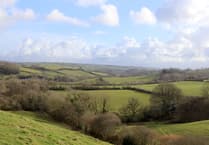THE world’s deepest dive was reached last month in a submarine created by two engineers from West Devon.
The Triton 36000/2 was jointly designed and created by Tom Blades from Morwellham and John Ramsay from Meavy — and on April 28 the machine successfully reached the planet’s deepest point — the Challenger Deep in the Pacific Ocean’s Mariana Trench, which is a distance of nearly seven miles from the surface of the ocean.
Headed up by Five Deeps Expedition the team reached a maximum depth of 10,928m — 16m deeper than any previous manned dive — which was piloted by Dallas businessman and explorer Victor Vescovo.
Tom is the principal systems engineer at Triton Submarines and based at the company’s main design office on Dartmoor. John is the principal design engineer for the company.
On hearing the news that his own creation had reached further than those before it, Tom said: ‘We were very confident in the design, however, sending a manned submersible to such extreme depths and successfully locating and navigating to the deepest point on earth is a hugely complex undertaking. All systems have to work flawlessly and there’s a lot that could go wrong and lead to an aborted dive.
‘We were surprised with how smoothly everything went. The weather was excellent.’
Tom operated the navigation and communications equipment on the surface and was heavily involved in the expedition at Challenger Deep.
‘The Triton 36000/2 model named “Limiting Factor” is designed to dive to over 11,000m, deeper than anywhere on earth and it’s the first time that a submersible has been certified for “unlimited diving depth”.
‘The important distinction with the Triton 36000/2 is that it’s capable of repeated dives to that depth. No other submersible has ever dived that deep and come back fully working, able to dive again. So rather than performing a one-off stunt, the Triton opens up the entire ocean to exploration by scientists. This is quite important, because most of the deep ocean is unexplored and scientists believe that its ecosystems are vital to life on earth.’
Other records were made during the expedition — it was the first time anyone had dived there twice and was the longest time a person had spent down in Challenger Deep. The team went on to make five dives in ten days — previously only three people had dived that deep, now eight have.
The Five Deeps Expedition is being filmed by Atlantic Productions for a five-part Discovery Channel documentary series due to air later this year.
The last visit to the bottom of Challenger Deep was made in 2012 by filmmaker and explorer James Cameron, who reached a depth of 10,908m on a dive in his submersible, the Deepsea Challenger.
Prior to Cameron’s dive, the first ever dive at Challenger Deep was made by the Trieste, a US Navy deep submergence bathyscape, in 1960, which was to 10,912m.
‘It is almost indescribable how excited all of us are about achieving what we just did,’ said Victor Vescovo after completing the dives.
‘This submarine, and its mother ship, along with its extraordinarily talented expedition team, took marine technology to an unprecedented new level by diving into the deepest, harshest area of the ocean.
‘We feel like we have just created, validated and opened a powerful door to discover and visit any place, any time, in the ocean — which is 90 per cent unexplored.’
Dr Don Walsh, captain, US Navy, retired, who made the deep dive on the Trieste back in 1960, praised Triton Submarines for its ‘technical brilliance’.
Patrick Lahey, president of Triton Submarines, who went to the bottom of Challenger Deep on one of Triton 36000/2’s dives with John Ramsay, said: ‘Our goal was to build a submersible capable of repeated dives to any depth.
‘Everyone at Triton is immensely proud to have had the privilege and opportunity to create such a remarkable craft.’
Triton Submarines, whose headquarters are in Sebastian, Florida, is the leading manufacturer of deep-diving submersibles for scientific research, exploration, TV and film, archaeology and personal submarines for super-yacht owners. The company’s submarines have also been used to film nature documentaries, including BBC’s Blue Planet 2, Galapagos and Sir David Attenborough’s Great Barrier Reef.
l John and Tom grew up in Elsham, North Lincolnshire. They both started out working together delivering the Scunthorpe Evening Telegraph on the paper round. Years went by and then they found themselves working together for the UK Submarine Rescue Team in Glasgow, which started their careers in submarines and eventually led them both to Dartmoor.
They were recently invited to visit Gulworthy Primary School to discuss their adventures and tell the pupils all about their careers in science and engineering. They conducted some experiments and showed them how to apply the science that they had been learning to real-life situations.




